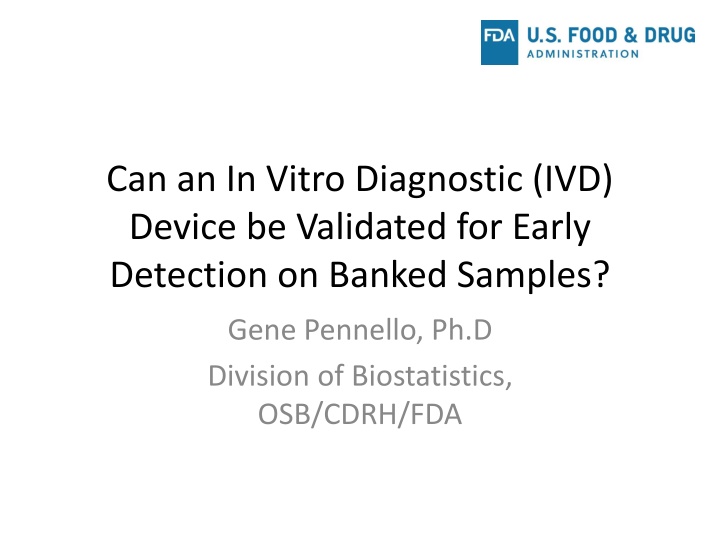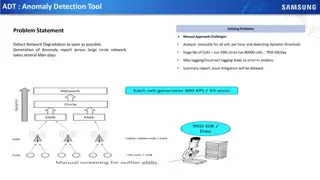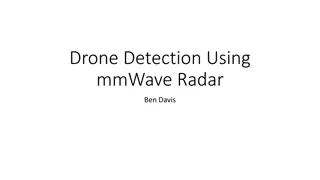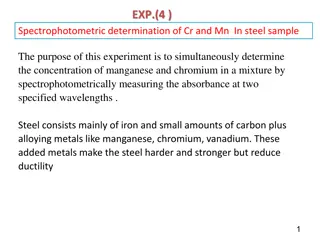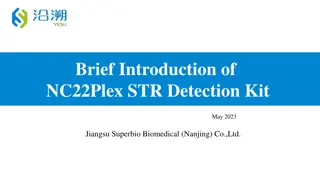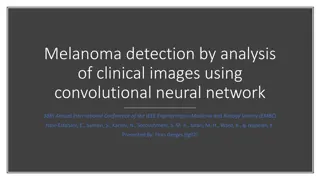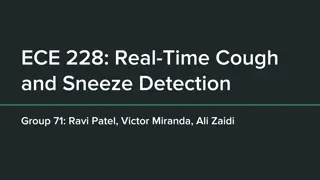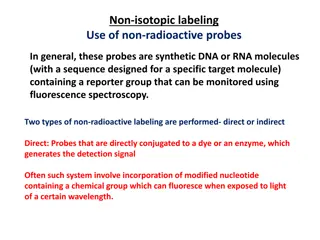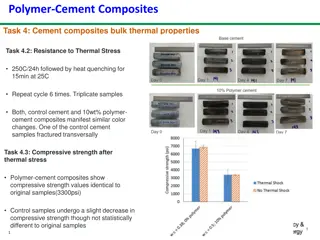Detection on Banked Samples?
In the process of validating an In Vitro Diagnostic (IVD) device for early detection on banked samples, factors such as analytical and clinical performance, clinical utility, and intended use must be assessed. This validation process is crucial for ensuring that the device is safe, effective, and provides reliable results for patient management. Regulatory considerations such as the least burdensome approach are also important to streamline the validation process and demonstrate device safety and effectiveness. The Cobas HPV Test, for instance, underwent rigorous evaluation in clinical studies to determine its effectiveness in screening for cervical cancer based on different cytology test results.
Download Presentation

Please find below an Image/Link to download the presentation.
The content on the website is provided AS IS for your information and personal use only. It may not be sold, licensed, or shared on other websites without obtaining consent from the author.If you encounter any issues during the download, it is possible that the publisher has removed the file from their server.
You are allowed to download the files provided on this website for personal or commercial use, subject to the condition that they are used lawfully. All files are the property of their respective owners.
The content on the website is provided AS IS for your information and personal use only. It may not be sold, licensed, or shared on other websites without obtaining consent from the author.
E N D
Presentation Transcript
Can an In Vitro Diagnostic (IVD) Device be Validated for Early Detection on Banked Samples? Gene Pennello, Ph.D Division of Biostatistics, OSB/CDRH/FDA
Medical Device Evaluation For indication(s) A (B, etc.), is device X safe, effective, have probable benefits that outweigh the probable risks, with reasonable assurance?
Diagnostic Device Evaluation Analytical performance - does my test measure the analyte I think it does? Correctly? How reliably? Clinical performance - does my test result correlate with target condition of interest in a clinically significant way? Clinical Utility - does my test support clinical decisions for patient management such as effective treatment or preventive strategies? 3
Intended Use & Indications for Use The driving force of the FDA review Determine the type of review Determine the data requirements Describe what the device measures, why, and in what population(s) it should be used 4
Least Burdensome the Secretary shall consider the least burdensome appropriate means necessary to demonstrate a reasonable assurance of device safety and effectiveness. Section 515(c)(5)(A) of FD&C Act, FDA Modernization Act, 1997. When clinical data are necessary, FDA and industry should consider the most efficient means of obtaining the evidence necessary to meet the regulatory need or standard . The Least Burdensome Provisions: Concept and Principles, Draft Guidance for Industry and FDA Staff, 2017. 5
Cobas HPV Test Original PMA. To screen patients ... with ASC- US (atypical squamous cells of undetermined significance) cervical cytology test results to determine the need for referral to colposcopy [reflex testing]. ATHENA Study ? 47,000
Cobas HPV Test PMA supplement. ... can be used as a first line primary cervical cancer screening test to detect high risk HPV [primary screening]. ATHENA Study ? 42,000 first ~62% samples collected were stored and were within the window for sample stability at the time of testing. The remaining ~38% samples collected were tested prospectively.
Diagnostic Devices, Radiology Multiple-reader multiple-case (MRMC) study Multiple study readers interpret results retrospectively from both the investigational and control device modalities. Selenia Dimensions 3D Breast Tomosynthesis generates digital mammographic images that can be used for screening and diagnosis of breast cancer. 302 of 3521 imaged subjects were selected for study: 76 cancer, 24 recalled, 76 benign, and 126 negative. Computer-aided detection (CAD) Use of specialized computer algorithms applied to medical information for improving the accuracy in detecting and/or discriminating disease by clinicians.
TOP2A FISH pharmDx Kit Device output: copy number changes (normal, deletions or amplifications) Claim: prognosis for recurrence or death Population: breast cancer patients Design: stored specimens from a randomized controlled trial in a retrospective analysis. the main design risk . . . was that missing blocks created a potential for unrepresentative results due to selection-bias The tissue was more often available when the prognostic factors were worse. (Summary of Safety and Effectiveness)
Keys to Prospectively Planned, Retrospective Validation 1. Adequate, well-conducted study with eligibility criteria the same as the assay. Specimens are available on a large predominance of subjects. Analysis plan is completely pre-specified. Assay demonstrates acceptable analytical performance on archived specimens. Assay result is obtained on a large portion of archived specimens. User of assay is masked to the clinical data. Mack. Nature Biotech, 2009, 27(2), 110-2. Subramanian, Simon. Nat Rev Clin Onc, 2010, 7, 327-34. Simon, Paik, Hayes, JNCI, 2009; 101, 1446-52. 2. 3. 4. 5. 6. 10 10
Endpoints / Claims Mortality Reduced incidence of late stage cancer Disease stage shift. Lead time / sensitivity of detection in preclinical disease phase. Diagnostic accuracy is superior to standard test or is non-inferior with other benefits (e.g., less invasive). Diagnostic accuracy is superior when test is used as adjunct to standard test. Intended use mitigates risk, e.g., OVA1: Patients with a pelvic mass scheduled for surgery Elevated risk referred to gynecologic oncologist for surgical treatment.
Absolute Risk Absolute risk is the probability that a subject who is free of the disease of interest at age a will be diagnosed with that disease in a subsequent age interval (a, t]. Relative risk (RR) is less clinically relevant than absolute risk: RR = 10 could mean 0.1% to 1%, or 1% to 10%.
MammaPrint Analytes: gene expression of 70 gene variants Endpoint: prognosis for recurrence or death Claim: risk of distant metastasis Population: breast cancer patients Study design: retrospective analysis of stored specimens from a well-defined cohort
Time to distant metastasis (N=302) 1.0 0.8 0.6 Probability 0.4 Patients Events Risk group 0.2 111 191 18 58 Gene signature low risk Gene signature high risk 0.0 0 2 4 6 8 10 12 14 Year 111 191 108 169 102 151 95 136 92 117 80 103 64 84 43 49 14 Number at risk
Proportion alive at 10 years Clinical Gene Signature N Proportion* Low Risk Low Risk High Risk High Risk Low Risk High Risk Low Risk High Risk 52 28 59 163 0.88 (0.74 to 0.95) 0.69 (0.45 to 0.84) 0.89 (0.77 to 0.95) 0.69 (0.61 to 0.76) *Buyse et al JNCI 2006 15
Estimating Absolute Risk in Sub-Samples of a Cohort Nested case-control design: At each time a case develops, sample individuals from risk set. Langholz and Borgan, 1997, Biometrics. v53. 767-774 Case-cohort design: Analyze data from subcohort selected at start of follow-up and all cases observed during follow up Raw data (e.g. serum samples) collected on all subjects at baseline, but analyzed only for cases and subcohort members. Self and Prentice, 1988. Ann. Statist. v16. 64-81. Barlow, 1994. Biometrics. v50. 1064-1072
Prospectively planned sample selection from a retrospective study population Intended use population (1) Study population Matched sample of controls Retrospective Study population Random sample of study pop (3) (2) All cases (1) Prospective-Retrospective design (2) Case-Cohort design (3) Nested Case-Control design 17
Nested Case Control Design Woodward 2005 For each case, a random selection of control(s) is taken from the cohort at risk at the time when the case got the disease. Biesheuvel et al 2008; Baker et al 2002; All (random subset) cases are included and a random sample of the controls is selected. Pepe et al, JNCI 2008 Randomly selected case patients and control subjects in the study cohort Matched sample of controls (3) All cases 18
Case Cohort Design All cases and a random subcohort. Advantages Subcohort can be used for multiple diseases Any time scale can be used Disadvantages Potentially more susceptible to bias than nested case-control Random sample of study pop (2) 19
Matched Case-Control Design Match controls with cases on known risk factors and other covariates, including Specimen collection site, processing site, and storage time; calendar time; age; gender; race; treatment (if applicable), etc. 20
Matched Case-Control Designs With [case-control] matched designs one can determine if there is some association between the marker and the outcome but one cannot quantify how well the marker performs as a classifier . Pepe, Fan, Seymour et al, Clin Chem 2012; 58:8, 1242-51. impact of the new marker on model performance can be substantially underestimated the incremental value of the same marker added to a model with standard risk factors tends to be grossly overestimated (an AUC increment of 0.02 vs 0.17). Pencina, Clin Chem 2012; 58:8, 1176-8.
Confounding Odds ratio association of test result with clinical condition can be adjusted for the effects of many categorical covariates using: Conditional logistic regression Cochran-Mantel-Haenzel estimate of OR
Intention to Treat (ITT) Intent to Treat (ITT): Include every subject who is randomized according to their treatment assignment, regardless of non-compliance with treatment, missing outcomes, protocol deviations, withdrawal, or anything else that happened after randomization. ITT analysis avoids overoptimistic estimates of treatment efficacy due to the exclusion of subjects on the basis of post-randomization variables. 23
Intention to Diagnose (ITD) Include every subject for analysis, even when data are not complete. Address missing data Report number (percent) of subjects without test results (sample unavailable; test result invalid, unevaluable, equivocal, etc.). Impute missing data, if meaningful for analysis. Sensitivity analysis (worst case, NI, MAR, NMAR) Imputation variables sampling method (e.g., biopsy, resection) sample characteristics handling and processing factors clinical variables, outcome
Endpoints / Claims Mortality Reduced incidence of late stage cancer Disease stage shift. Lead time / sensitivity of detection in preclinical disease phase. Diagnostic accuracy is superior to standard test or is non-inferior with other benefits (e.g., less invasive). Diagnostic accuracy is superior when test is used as adjunct to standard test. Intended use mitigates risk, e.g., OVA1: Patients with a pelvic mass scheduled for surgery Elevated risk referred to gynecologic oncologist for surgical treatment.
Take Homes Prospectively planned, retrospective studies have been the basis of approval of diagnostic devices for cancer screening or diagnosis. Enrichment designs have been considered. Study population should be representative of IU population of the device. Cohort being sampled should be well-defined. Avoid convenience sampling. Presubmission (q-sub) meeting with CDRH is strongly encouraged. Before your diagnostic device is applied to stored specimens in a retrospective clinical validation study, validate its analytical performance.
Analytical Performance Studies Bias, relative to a reference method for measuring analyte. Precision. Measurement variation in repeated testing. repeatability of the test result taken under the same set of conditions (e.g., testing sample replicates in the same run) reproducibility of test result taken under different conditions (e.g., testing sample replicates in different labs) Limit of Detection. Smallest analyte level detected reliably. Reagent Stability. Shelf-life, in-use, and shipment. Analytical Specificity. Measurement of a specific analyte in the presence of potential interfering substances, cross-reactivity, or cross-contamination. Commutability of different sample types, when processed samples are used in place of clinical samples. Reference Interval. Central XX% of test values in healthy individuals. CLSI. A Framework for Utilizing CLSI Guidelines to Evaluate Clinical Laboratory Measurement Procedures; 2nd ed, CLSI report EP19. Wayne, PA: Clinical and Laboratory Standards Institute; 2015. 27
References: Case-Control, Case- Cohort, Nested Case-Control Designs Rodrigues, Kirkwood. Case-control designs in the study of common disease; Updates on the demise of the rare disease assumption and the choice of sampling scheme for controls, Intern J Epidem 1990; 19(1), 205- 218. Janes H, Pepe MS. Matching in Studies of Classification Accuracy: Implications for Analysis, Efficiency, and Assessment of Incremental Value, Biometrics 2008; 64, 1-9. Kleinbaum DG, Kupper LL, Morgenstern H. Epidemiologic Research, Van Nostrand Reinhold, 1982, Ch. 11, Selection Bias. Barlow WE, Ichikawa L, Rosner D, Izumi S. Analysis of Case-Cohort Designs. J Clin Epidem 1999; 52(12):1165-1172. Pepe MS, Feng Z, Janes H, Bossuyt PM, Potter JD, Pivotal Evaluation of the Accuracy of a Biomarker Used for Classification or Prediction: Standards for Study Design, J Natl Cancer Inst 2008;100: 1432-1438. Wacholder, Practical Considerations in Choosing between the Case- Cohort and Nested Case-Control Designs, Epidemiology 1991; 2(2): 155-158. Baker SG , Kramer BS , Srivastava S . Markers for early detection of cancer: statistical guidelines for nested case-control studies . BMC Med Res Methodol . 2002 ; 2 : 4 . 28
Acknowledgements OIR DBS 29
